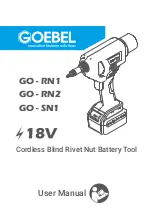
2
IMPORTANT SAFETY
INSTRUCTIONS
WARNING
Read all safety warnings and all
instructions.
Failure to follow the
warnings and instructions may result in electric
shock, fire and/or serious injury.
Save all warnings
and instructions for future reference.
WORK AREA SAFETY
• To reduce the risk of injury, close supervision is
necessary
when an appliance is used near children.
ELECTRICAL SAFETY
• Power cord plugs must match the outlet. Never
modify the plug in any way. Do not use any
adapter plugs with earthed (grounded) power
tools.
Unmodified plugs and matching outlets will
reduce risk of electric shock.
• Avoid body contact with earthed or grounded
surfaces, such as pipes, radiators, ranges and
refrigerators.
There is an increased risk of electric
shock if your body is earthed or grounded.
• To reduce the risk of electric shock, do not put
equipment in water or other liquid.
Do not place
or store appliance where it can fall or be pulled into
a tub or sink.
• Do not abuse the cord. Never use the
cord for carrying, pulling or unplugging
the power tool. Keep cord away from
heat, oil, sharp edges or moving parts.
• Arrange cords carefully to avoid hazardous
environments.
Tripping or snagging on cords can
cause injury and product damage. Do not allow
cords to run through puddles or across wet ground.
• Do not unplug by pulling on the cord.
To unplug,
grasp the plug, not the cord.
• Unplug the cord from outlet when not in use and
before servicing or cleaning.
• Always use a suitable extension cord to reduce
the risk of electric shock.
• If operating a equipment in a damp location is
unavoidable, use a ground fault circuit inter
-
rupter (GFCI) protected supply.
Use of an GFCI
reduces the risk of electric shock.
PERSONAL SAFETY
• Do not overreach. Keep proper footing and bal
-
ance at all times.
This enables better control of the
power supply in unexpected situations.
• Do not use on a ladder or unstable support.
Stable footing on a solid surface enables better
control of the power supply in unexpected situations.
BATTERY TOOL USE AND CARE
• Recharge only with the charger specified by the
manufacturer.
A charger that is suitable for one type
of battery pack may create a risk of fire when used
with another battery pack.
• Use power supply only with specifically des
-
ignated battery packs.
Use of any other battery
packs may create a risk of injury and fire.
• Do not short circuit.
A short-circuited battery
pack may cause fire, personal injury, and product
damage. A battery pack will short circuit if a metal
object makes a connection between the positive and
negative contacts on the battery pack. Do not place
a battery pack near anything that may cause a short
circuit, such as coins, keys or nails in your pocket.
•Do not allow fluids to flow into battery pack.
Corrosive or conductive fluids, such as seawater,
certain industrial chemicals, and bleach or bleach
containing products, etc., can cause a short circuit.
• Under abusive conditions, liquid may be ejected
from the battery; avoid contact. If contact acci
-
dentally occurs, flush with water. If liquid con
-
tacts eyes, additionally seek medical help.
Liquid
ejected from the battery may cause irritation or burns.
• Do not use a battery pack or equipment that is
damaged or modified.
Damaged or modified bat
-
teries may exhibit unpredictable behavior resulting
in fire, explosion or risk of injury.
• Do not expose a battery pack or equipment to
fire or excessive temperature.
Exposure to fire
or temperature above 265°F (130°C) may cause
explosion.
• Follow all charging instructions and do not
charge the battery pack or equipment outside
the temperature range specified in the instruc
-
tions.
Charging improperly or at temperatures
outside the specified range may damage the battery
and increase the risk of fire.
CHARGER USE AND CARE
• Caution - To reduce the risk of injury, charge
MILWAUKEE Lithium-Ion packs only in their
MILWAUKEE Lithium-Ion charger.
Other types
of batteries may burst causing personal injury and
damage. Do not wire a battery pack to a power
supply plug or car cigarette lighter. Batteries will be
permanently disabled or damaged.
• Charge only MILWAUKEE MX™ Lithium-Ion
packs.
Other types of batteries may burst causing
personal injury or damage.
• Avoid dangerous environments.
Do not charge
battery pack in rain, snow, damp or wet locations.
Do not use battery pack or charger in the presence
of explosive atmospheres (gaseous fumes, dust
or flammable materials) because sparks may be
generated when inserting or removing battery pack,
possibly causing fire.
• Charge in a well ventilated area.
Do not block
charger vents. Keep them clear to allow proper
ventilation. Do not allow smoking or open flames
near a charging battery pack. Vented gases may
explode.
• Maintain charger cord.
When unplugging char-
ger, pull plug rather than cord to reduce the risk of
damage to the electrical plug and cord. Never carry
charger by its cord. Keep cord from heat, oil and
sharp edges. Make sure cord will not be stepped on,
tripped over or subjected to damage or stress. Do
not use charger with damaged cord or plug. Have
a damaged charger replaced immediately.
• Use only recommended attachments.
Use of an
attachment not recommended or sold by the battery
charger or battery pack manufacturer may result in
a risk of fire, electric shock or personal injury.
• Unplug charger
when not in use. Remove battery
packs from unplugged chargers.
• To reduce the risk of electric shock,
always un-
plug charger before cleaning or maintenance. Do
not allow water to flow into plug. Use a Ground Fault
Circuit Interrupter (GFCI) to reduce shock hazards.
• Store your battery and charger
in a cool, dry place.
Do not store battery pack where temperatures may
exceed 120°F (50°C) such as in direct sunlight, a
vehicle or metal building during the summer.



































